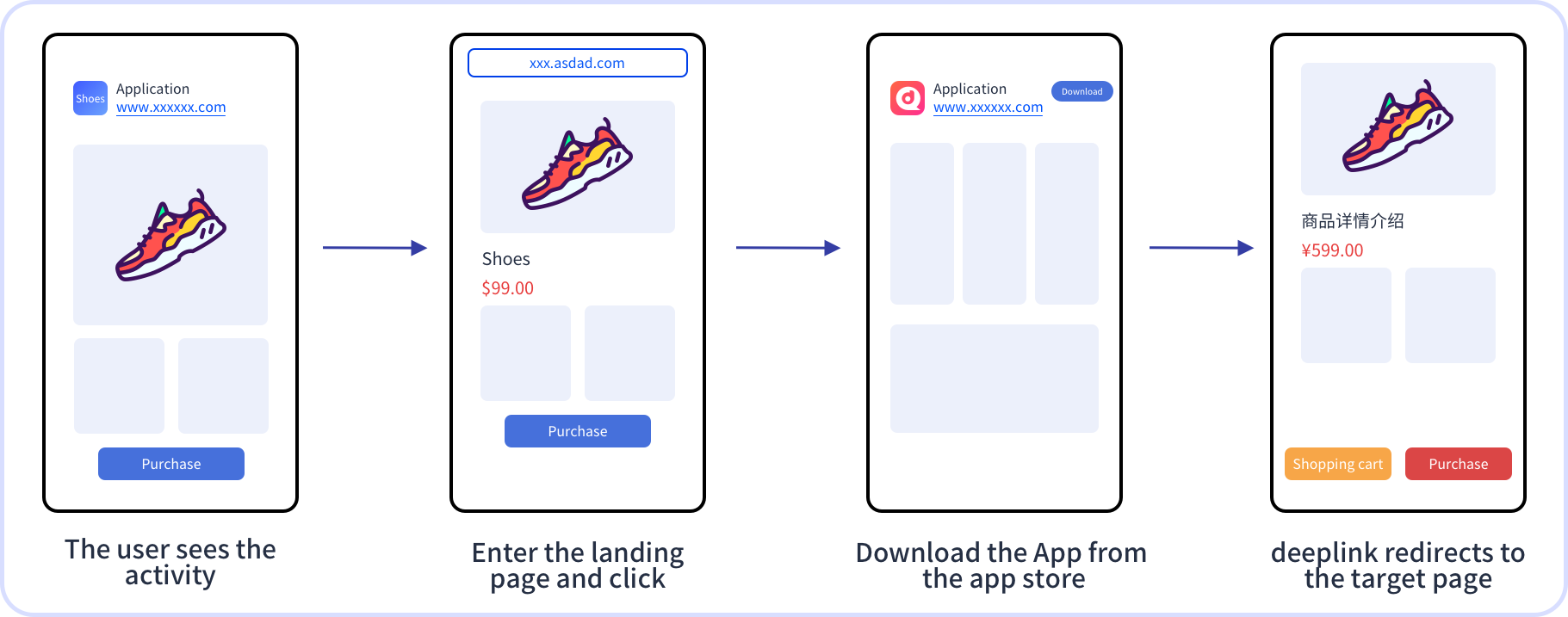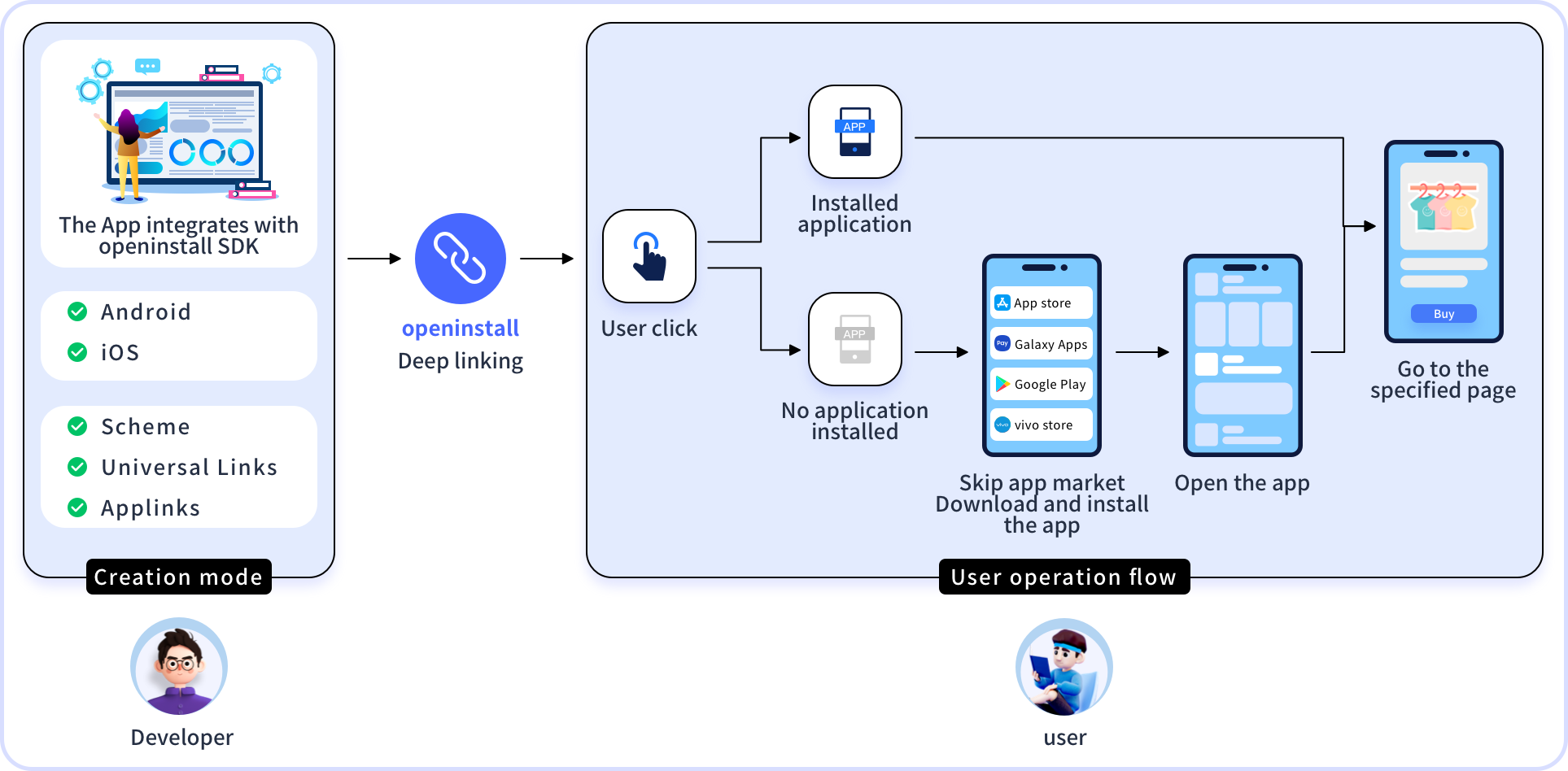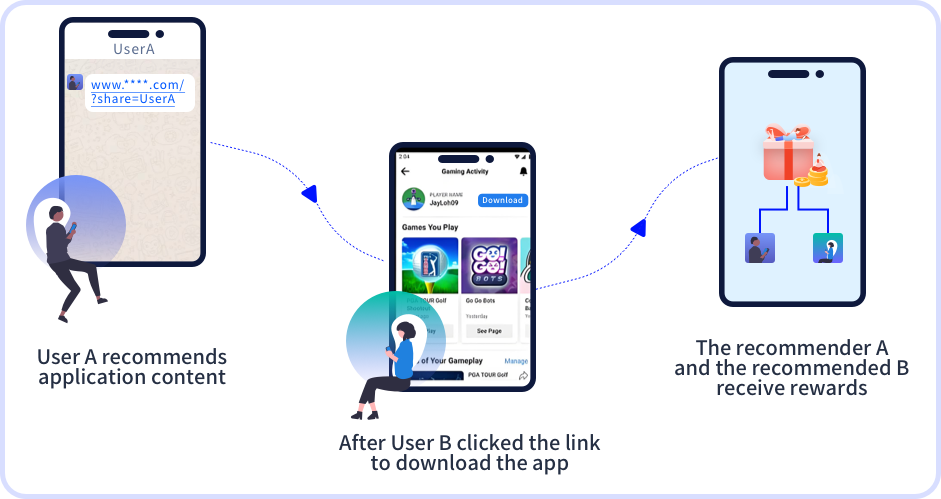
openinstall:deep linking and scene restoration
- 2025.07.08 11:20
- openinstall
- Openinstall News
In the mobile app ecosystem, users often need to navigate multiple touchpoints—such as web pages, app stores, and in-app pages—from clicking an ad to completing core actions like placing an order, registering, or consuming content. During this journey, “redirect gaps” become the biggest black hole for user attrition: users may abandon their target actions due to broken paths, repetitive operations, or chaotic page redirects.
DeepLink technology (referred to as “app wake-up,” “context restoration,” or similar terms in different scenarios) is the core solution to this problem. It is not a collection of isolated technologies but a unified redirect logic that eliminates path discontinuities, enabling users to “one-tap access” target pages from any entry point, thereby creating a seamless experience.

I. Technical Universality: One Logic, Multi-Scenario Adaptation
The core goal of DeepLink technology remains consistent: to ensure users accurately reach preset pages regardless of their access channel or device state (app installed/not installed). While this capability is labeled differently across scenarios, its underlying logic is identical:
- When the app is installed: Links directly wake up the app and redirect to the target page (often called “app wake-up”).
- When the app is not installed: User click behavior is automatically recorded, and the target page is restored post-installation (i.e., “deferred DeepLink”).
In essence, DeepLink maintains behavioral continuity through parameter transfers during cross-platform operations (e.g., web-to-app transitions).
Take e-commerce as an example: A user clicks a “limited-time discount” ad link on social media. If the app is installed, they directly land on the product page; if not, the discount information is preserved and automatically loaded post-installation. This “seamless transition” relies on DeepLink’s natural adaptation to different user states, rather than a patchwork of multiple technologies.

II. Openinstall Scenarios: Technology-Driven Business Growth
DeepLink’s “click-to-direct-access” capability is reshaping mobile app operational efficiency and user experience. Below are practical examples of how it drives growth across business stages:
Scenario 1: Simplified Paths Boost Conversion Rates
Traditional in-app navigation often involves lengthy steps with high attrition risks. For a travel app:
- Without DeepLink: Users follow a 6-step path: “promo link → search bar → keyword input → result filtering → target content.” Mismatched search results may lead to abandonment.
- With DeepLink: Users click a shared recipe link, waking the app and jumping directly to the target page in 2 steps. Operations are reduced by 60%.
This “one-step access” is ideal for high-conversion scenarios like e-commerce promotions or content consumption, significantly lowering user effort.
Scenario 2: Precision Reactivation of Dormant Users
Generic push notifications often fail to re-engage inactive users. DeepLink enables targeted strategies:
- Tactics: Create time-sensitive offers (e.g., discounts, stock alerts, VIP perks) with DeepLinks containing page-specific parameters, delivered via SMS, email, or push.
- User Flow: Clicking the link wakes the app (if installed) to the campaign page, guiding actions like purchases. For non-installed users, post-download auto-redirect ensures continuity.
One e-commerce app achieved a 40% increase in dormant user reactivation and 2x longer campaign page dwell time using “exclusive discounts + DeepLink.”
Scenario 3: Web-to-App User Migration
Converting mobile web users to app users is notoriously challenging. DeepLink bridges the gap:
- Web Design: Embed DeepLinks in H5 pages (e.g., “Open App for More” buttons).
- User Flow: Installed users jump directly to in-app pages; non-installed users are guided to download, with post-install auto-redirect.
This breaks the “download-disconnect” cycle, boosting conversion rates while enhancing user experience.
Scenario 4: Social Sharing for Viral Growth
Traditional referral links often lose post-install attribution. DeepLink fixes this:
- Tactics: Users share DeepLinks tied to referral IDs (e.g., group buys, cashback).
- Conversion Path: Clicking the link wakes the app (if installed) to the campaign page with referral rewards pre-linked. Non-installed users retain referral data post-download.
A social commerce platform saw 50% higher paid conversion rates and 30% lower acquisition costs using “invite-rewards + DeepLink.”

III. Implementation: Low-Barrier Integration
Despite its value, developers face challenges like cross-platform compatibility and parameter loss (e.g., Android/iOS differences, app store intercepts).
openinstall, a DeepLink solution provider, simplifies implementation with:
- 10-Minute Integration: Lightweight SDKs auto-adapt to Android, iOS, HarmonyOS, and H5, eliminating platform-specific coding.
- Smart Parameter Transfer: Automatically captures channel sources, device info, and user behavior, breaking data silos.
- Full-Journey Tracking: Monitors user paths from click to conversion, empowering data-driven decisions.
Recent Posts
- OpenInstall Omnichannel Multi-scenario Solution
- Having trouble acquiring users and achieving conversions for your app? Here are solutions based on real-world examples.
- openinstall: A solution for attribution and redirection from web to app (W2A).
- How to efficiently use app data statistics
- In today’s wave of social networks, how should developers make good use of omni-channel statistics?
- ASA Attribution Statistics: Breaking Through the Gap in iOS Customer Acquisition Data from a Developer’s Perspective, Making Advertising Decisions More Traceable
- Openinstall Core Function Usage Guid
- What benefits can a Web to App attribution solution bring?
- IMore than just “data calculation”: The underlying logic of APP channel agent statistics is the key to doubling conversion efficiency
- How to Use App Install Parameters for Channel Attribution



